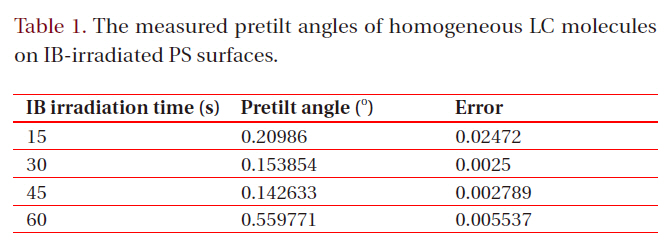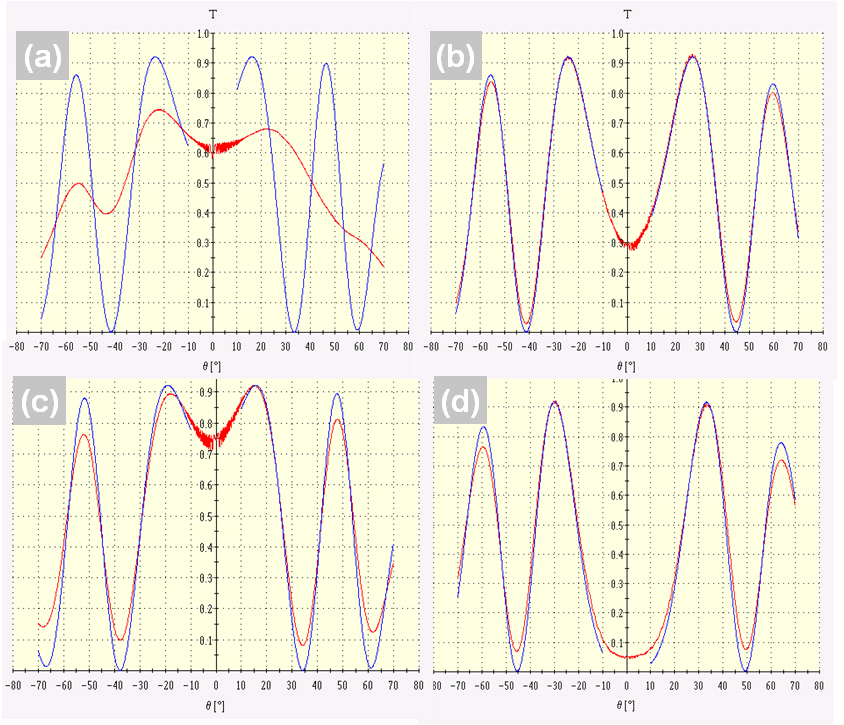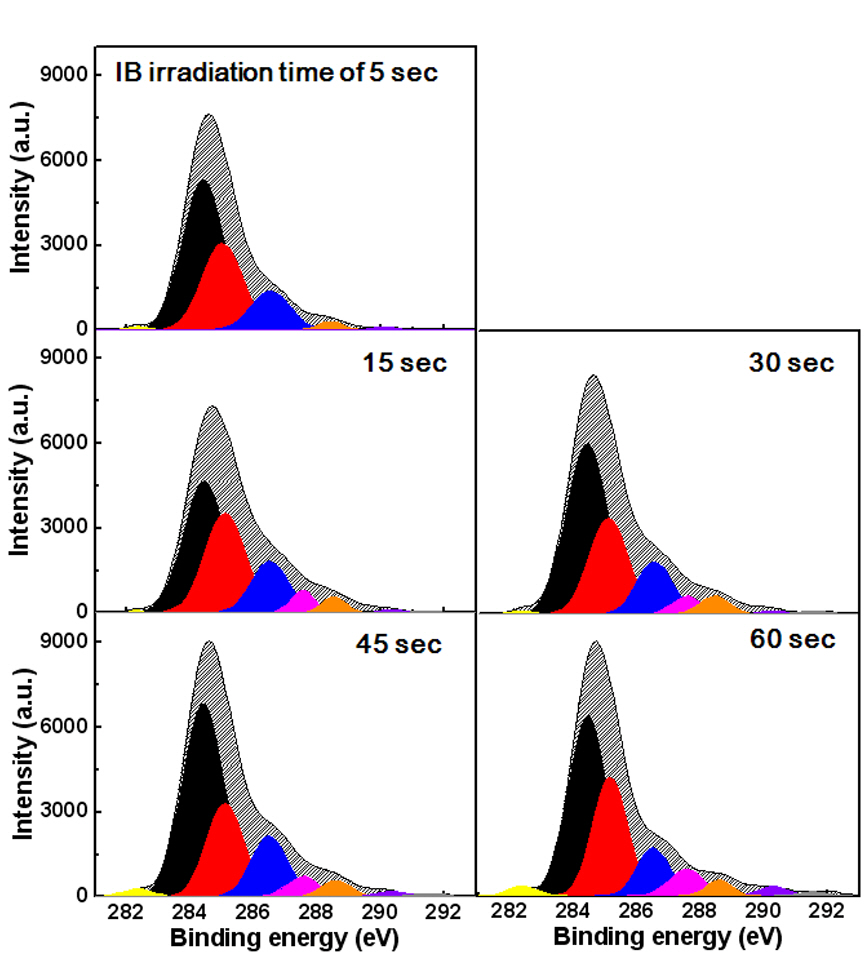



This paper introduces homogeneous liquid crystal (LC) orientations on chemically modulated polystyrene (PS) surfaces using various ion beam (IB) exposure times. Transparent PS was replaced with conventional polyimide material. As a non-contact process, the IB bombardment process induced LC orientation parallel to the IB process.Through x-ray photoelectron spectroscopy, it was shown that the chemical compositional changes of the IB-irradiated PS surfaces were determined as a function of IB exposure time. Using this analysis, the optimal IB bombardment condition was determined at an IB exposure time of up to 15 seconds. Moreover, thermal stability on IB-irradiated PS surfaces were carried out which showed that a relatively high IB exposure time induced a thermally stable LC alignment property.
Interactions between liquid crystal (LC) molecules and LC alignment surfaces possess significance in both fundamental research and liquid-crystal display (LCD) applications [1,2]. Organic and inorganic LC alignment layers have been widely studied by several groups [3-6]. Although inorganic LC alignment layers have garnered wide attention [4,5], the study of organic materials for LC alignment layers such as polyimide (PI) and polystyrene (PS) should also be allotted attention because of the ease in coating organic materials on glass substrates. Moreover, with the many disadvantages associated with mechanical rubbing, a noncontact LC alignment method has become the most promising substitute for the conventional method [3-x]. A rubbed polymer surface includes debris left by cloth, and the generation of electrostatic charges during rubbing induces local defects, streaks, and a grating-like wavy surface due to nonuniform microgrooves that degrade the display resolution. Non-contact alternatives,including ultraviolet (UV) exposure [4,7,8], ion beam (IB) bombardment [3,5,6], and nanoimprinting lithography [9], have been reported. Of these, the UV alignment method exhibits advantages of being a clean process, and having large-scale manufacturing and multidomain capabilities; although UV stability, low anchoring energy, and alignment materials must be considered carefully. In contrast, the IB alignment method has none of the drawbacks of the UV alignment method.
As an LC alignment material, the refractive index of PS is nearly the same as that of glass substrate, implying that the transparent PS material is a candidate for an organic alignment material.PS material was studied by another group, which shows that IB treatment broke phenyl rings of the PS material selectively. However, further studies are needed using IB treatment for applying PS material. Our study will provide a more detailed investigation under various IB experimental conditions. To align the homogeneous LC molecules on the PS layers, IB irradiation as a function of IB exposure time was used. Observing the conditions of the homogeneously aligned LC molecules helped to determine the optimal IB exposure time. Additionally, the chemical changes before and after the IB irradiation process on the PS surfaces were examined using X-ray photoelectron spectroscopy (XPS) analysis.
PS (from Aldrich) was used as the alignment layers. PS was dis-
[Table 1.] The measured pretilt angles of homogeneous LC molecules on IB-irradiated PS surfaces.

The measured pretilt angles of homogeneous LC molecules on IB-irradiated PS surfaces.
solved in toluene to form a solution of 1.4 wt% concentration. Indium tin oxide (ITO)-coated glass substrates were supersonically cleaned in a trichloroethylene-acetone-methanol-deionized water solution sequentially for 15 minutes, and then dried with N2 gas. The PS solution was spin-coated onto ITO-coated glass and the coated substrates were soft-baked at 80℃ for 10 minutes and imidized at 230℃ for 1 hour. The PS surfaces were irradiated with an Ar IB plasma using a DuoPIGatron-type IB system[6]. The IB chamber was initially evacuated to a base pressure of approximately 10-6 torr, and the working pressure was maintained at approximately 10-4 torr with an Ar gas flow of 1.4 sccm.The IB bombardment was conducted for times 15, 30, 45, and 60 seconds with exposure energy and angle of 2 keV and 45°, respectively. These substrates were fabricated in an antiparallel configuration with cell gap of 60 m, and were used to measure the pretilt angle and thermal stability. A positive LC (MJ001929,Tc = 72℃, △e = 8.2, n = 0.777; Merck co, ltd, Germany) was injected into the cell and assembled. To measure the pretilt angles of homogeneous LC molecules on the IB-irradiated PS surfaces, a crystal rotation method (TBA 107, Tilt-bias Angle Evaluation Device; Autotronic co, ltd, Japan) was used, observing the oscillation of the transmittance of LC cells (60 m cell gap) with a latitudinal rotation from -70° to 70° through the variation of the birefringence produced by LC cell rotation. Thermal stabilities for LC cells were observed to estimate the LC anchoring energy. After the LC cell was annealed by specific heat and gradually cooled, the LC alignment effect was observed by photomicroscope. All IB-irradiated PS surfaces were examined using XPS (220-XL; VG Scientific, ESCA LAB co, ltd, USA) analysis. The measured bindings were referred to the C1s signal at 284.6 eV, and the composition of each sample was determined to compare the normalized area intensities of the C1s peaks.
Figure 1 shows the transmittance characteristics as a function of exposure time for measuring the pretilt angles of the LCs on the PS surface. Figures 1(b-d) show stable graphs of the pretilt angles of LC on the PS surface. The error ratios, which are represented by the difference between the blue and red curves in Fig.1, were low, indicating well-aligned homogeneous LC orientation.However, Fig. 1 (a) exhibits a high error ratio, indicating that a well-aligned LC on the PS surfaces was achieved when IB exposure time was up to 30 seconds. Table 1 shows the measured pretilt angles of homogeneous LCs on IB-irradiated PS surfaces.As seen, all pretilt angles were 0-1°. However, we confirmed that LCs were randomly aligned on the PS surface at an exposure time of 15 seconds. Here, the important thing is that the LCs were aligned parallel to the direction of IB exposure while using an IB process. Generally, the LC orientation achieved is in a direction orthogonal to the rubbing process [10,11]. This difference arose because IB irradiation produces very dominant dipole-dipole interactions that induce the LCs on the PS surface to align in a direction parallel to the direction of IB irradiation.
Figure 2 shows the microscope images of the fabricated LC
cells as a function of annealing temperatures in order to examine the relationship between the ability of the LCs to maintain their orientation and thermal stability. To examine the thermal stability of the LC cells, the cells were annealed at 100, 150, 200℃ for 10 minutes. All images were the same until the annealing temperature reached 100℃. As mentioned above, randomly aligned LCs were obtained on IB-irradiated PS surfaces with IB exposure times of 5 and 15 seconds. Destruction of the LC orientation on the IB-irradiated PS surface with an IB exposure time of 30 seconds started at an annealing temperature of 100℃. In contrast, the LC orientations of the other cells obtained using IB exposure times of 45 and 60 seconds were stable at a temperature of 100℃. As the annealing temperature was increased to 150℃, the LC orientation induced by the IB exposure time of 45 seconds was destroyed. Eventually, the LC orientations on all LC cells were destroyed at an annealing temperature of 200℃. These results indicate that a relatively high IB exposure time resulted in strong thermal dipole-dipole interactions between PS surfaces and homogeneous LC molecules allowing them to maintain their LC orientation with a stable thermal property. Also, we can see that LC cells fabricated by IB-irradiated PS surface have good thermal stability comparable to PI-based LC cell.
The chemical binding characteristics of the atoms on the PS surfaces were analyzed by a series of XPS spectra of C 1s core levels [12-14], and the changes in composition of the LC alignment
layers before and after IB irradiation are shown in Fig. 3. Figure 3 shows the measured C 1s spectra, in which the dominant peak component of the aromatic carbon area was located at 284.5 ±0.1 eV. The component peak at 285 ± 0.1 eV is related to the CH atoms, and the low binding energy at 282.3 ± 0.1 eV is due to the surface contamination of C 1s. The component peak located at 286.4 ± 0.1 eV is related to the C-OR bonds, the component peak centered at 288.6 ± 0.1 eV corresponds to the O-C=O bonds and the component peak at the 291.5 ± 0.1 eV is from the broad armotic shake up. In Fig. 3, the peak corresponds to the carbons on the phenyl ring, which increased and was saturated over an IB exposure time of 15 seconds. Also, we observed the newly produced C=O bonds centered at 287.6 ± 0.1 eV between the IB exposure times of 15 seconds and 60 seconds, although the production was scant at 5 seconds. The increment of C=O peak indicated the reformation of the phenyl ring. That is, IB bombardment transformed carbon oxide bonds on the PS surfaces into C=O bonds in the direction of the anisotropic IB exposure process via surface oxidization [13-14].
Although the breaking phenomena of aromatic carbon and CH were noticeably detected, the produced C=O bonds strongly contributed to the LC alignment properties on the PS surfaces. Therefore, the produced C=O and the selective bonding breaking could induce anisotropic dipole fields to align the LC molecules.
In this study, the homogeneous PS material for the LC alignment layer was modified by IB irradiation at various IB exposure times with fixed IB bombardment energy and a fixed exposure angle in order to replace conventional rubbing technology and PI material for LCD applications. An increase in IB exposure time resulted in a stable and clear LC orientation with matching of experimental crystal rotation graphs. Uniformly aligned LC molecules on an IB irradiated PS surface was achieved for an IB exposure time of 15 seconds. Moreover, the thermal stability of the LC cells also increased as the IB exposure time increased, indicating that the IB bombardment method can result in a uniform thermally stable surface on an IB-irradiated PS alignment layer by inducing anisotropic dipole-dipole interactions due to bond reformations and breakages. In other words, the IB-irradiated PS materials helped to extend the lifetime of LCD devices with a highly stable thermal property.



